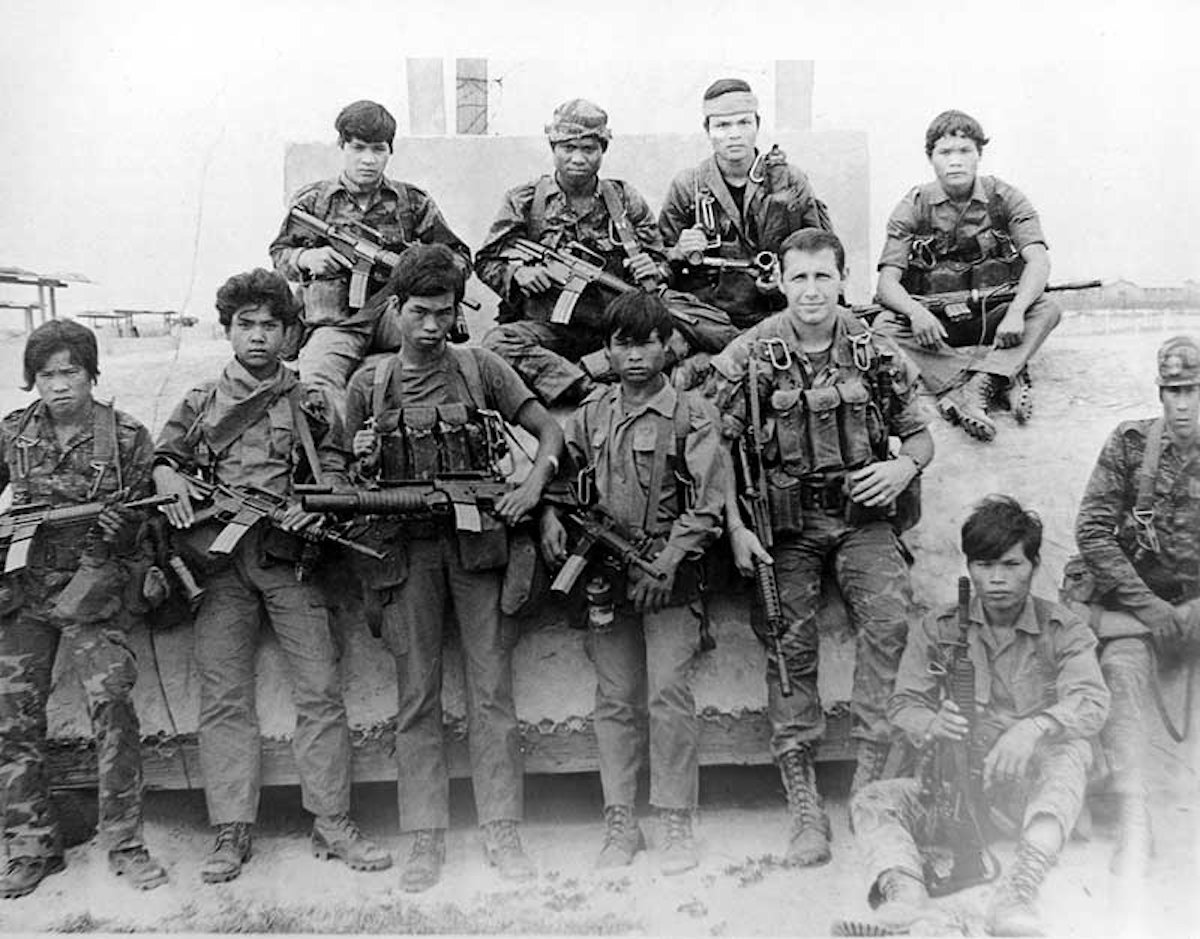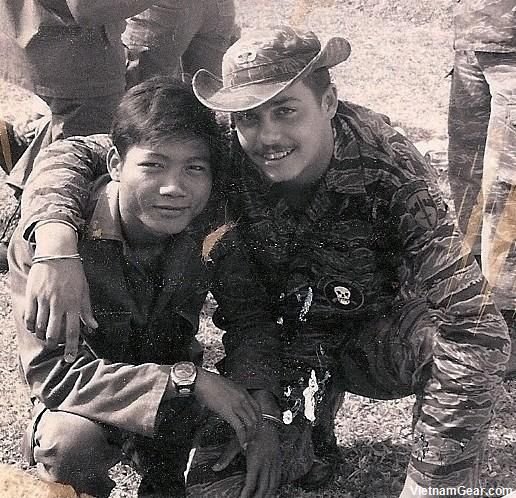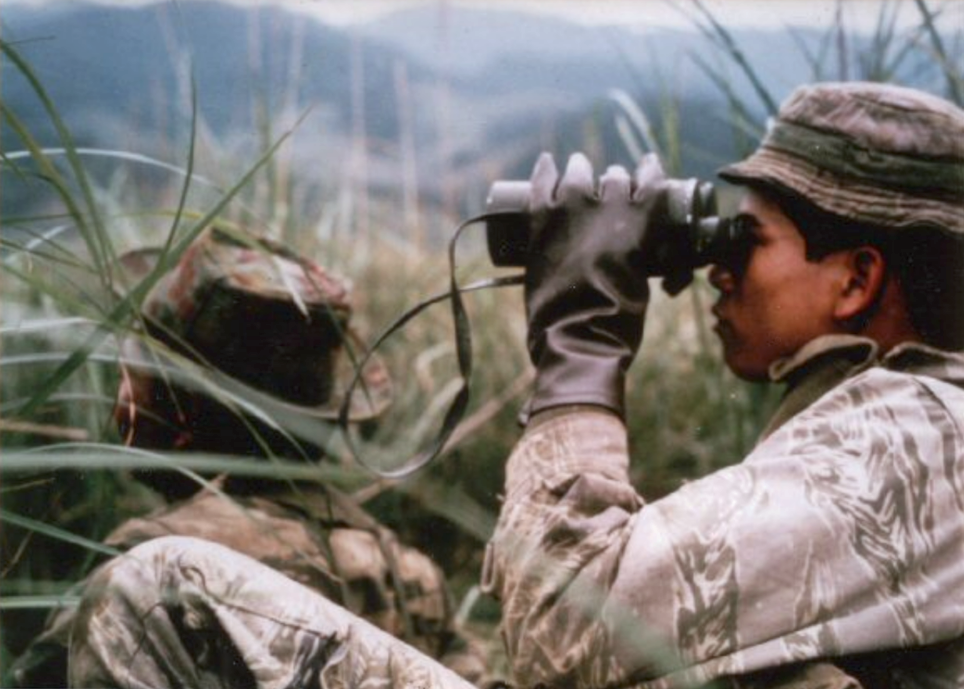
An Army Special Forces soldier with his team of Montagnards in Vietnam. Photo courtesy of the Montagnard Assistance Project.
Wearing an enemy uniform and crawling alone through dark tunnels under a Vietnamese mountain, K’Sao Krajan fought alongside soldiers of the 5th Special Forces Group. His actions were as fierce and heroic as those of any among that unit. With the American Green Berets pinned down in an ambush, Krajan — a member of the Montagnards, the native tribes of Vietnam’s Central Highlands — found the entrance to the caves and tunnels the enemy was firing from. Entering on his own and donning a Viet Cong uniform, Krajan cleared the cave, killing fighters as he went. He emerged at the top of the tunnel system and waved at the Americans below, signaling for them to escape the kill zone.
For his actions, Krajan was awarded a Bronze Star, and the story has been passed down in his family, who relocated to outside Charlotte, North Carolina.
Krajan was not alone in his bravery among the Montagnard (MON-ten-YARD) people, spread across 30 or so tribes and more than six ethnic groups in Vietnam’s highlands. Their fight alongside American soldiers in Vietnam remains one of the undertold tales of indigenous forces that aided the US war effort.
The Montagnard people — as they were called by the French after the word for “mountain dweller” — fought beside the French colonists, gaining a strong reputation on the battlefield. They had, at best, distant connections to the central South Vietnam government, which in the early 1960s was headed by President Ngo Dinh Diem. The US feared that the thin loyalty to Diem’s government could make the Montagnards easy recruits to the cause of the Communist North. Between the French Indochina War (immediately following World War II) and the Vietnam War, more than a million Montagnards were killed and 85% of their villages destroyed or abandoned.

Despite decades of suffering, the Montagnards formed a unique bond with the US Army Special Forces soldiers whom they fought and died alongside. US forces first made contact with the Montagnards in October 1961. David Nuttle, an International Voluntary Services official with two years of experience working on agricultural projects across South Vietnam, and Staff Sgt. Paul Campbell, an Army Special Forces medic, arrived in a small Montagnard village called Buon Enao. Campbell recruited village elders to the “Buon Enao Experiment,” which was intended to improve living conditions, agricultural means, and medical facilities while standing up a defense system around the village to encourage defiance against the forces of the north.
The Montagnards encompass distinct tribes with their own languages, cultures, and religious beliefs. But as larger powers came to Vietnam, each sought out Montagnards for military help.
“You could always tell the villages where the missionaries had been,” Nuttle told the Chicago Tribune in 1987, referencing the decades-long French Indochina War (1946-1954) that impacted the region. “The women would be wearing bras. And where the French had been, you’d see somebody dressed in out-of-date Parisian fashions standing next to a guy in a loincloth.”
The two Americans gained the trust of the Montagnards in Buon Enao and formed the Village Defense Program (VDP). As the VDP expanded to neighboring villages, the Buon Enao Experiment was expanded. The CIA operation shifted by 1962 with Army Special Forces ODA teams training 1,300 Montagnards from 40 neighboring villages. About 300 were selected to form three 100-man Mobile Strike Force companies, or MIKE Force.
A bond with the Green Berets was built first in training. Russell Mann, another Army Special Forces soldier, recalled teaching the “Yards,” a nickname for the Montagnards, how to safely throw hand grenades. One bounced off a berm and rolled back toward his feet. “The subsequent mud-soaked exit was a source of great amusement to the tribesmen,” Mann said. “I developed a great fondness for the Yards. If it was a slow day, I would occasionally dive into the trench just to amuse them.”
In battle, the Montagnards were indefatigable. “They were never defeated,” said George Clark, a 5th Special Forces Group Green Beret who served with MIKE Force between 1967 and 1970. “They may have been overrun, but they always took it back. We had full faith in the Montagnards.”
Montagnard war heroes were not all men. Ha Srin was just 21 years old when she joined a detachment of Green Berets in Vietnam. She ultimately reached the rank of colonel with 18 years of combat experience to her name. In 2015 she participated alongside Green Beret instructors during Robin Sage, the culminating event for candidates entering the Special Forces ranks.
Although roughly 61,000 Montagnards aided the US by the Vietnam War’s end, once the US military pulled out, support for them evaporated. “When we pulled out of Vietnam,” Clark said, “those villages were screwed, and we knew it.”
The Montagnards, some 12,000 total, fled the jungles of Vietnam, Cambodia, and Thailand, and from 1975 to 1992, formed the Front de Liberation des Hauts-Plateaux Montagnard (FLHPM) to fight against the communist government of Vietnam. They were targeted and pursued through military action, killed by tigers and snakebites, and died of disease and starvation. Only 600 are believed to have survived.

When Americans returned to the States, the Green Berets didn’t forget.
“I keep telling people the Montagnards are America’s forgotten Vietnam veterans and they deserve our help,” Campbell told the Washington Post in 1994. Campbell has helped Montagnard veterans relocate to North Carolina.
Another Green Beret, David Hicks, gave an interview in 2002 to The Associated Press in which he could not hide his deep emotions about the fate of the people he, like Russell Mann, affectionately called the “Yards.” “I am so unhappy about us walking out on them that when I die and they fold my flag, I will die ashamed,” Hicks said.
America’s forgotten Vietnam veterans today are receiving the support they deserve thanks to the help of the Montagnard Assistance Project. It exists “to provide financial and humanitarian assistance to Montagnard asylum seekers and refugees who have fled persecution in Vietnam.”
Read Next:

Matt Fratus is a history staff writer for Coffee or Die. He prides himself on uncovering the most fascinating tales of history by sharing them through any means of engaging storytelling. He writes for his micro-blog @LateNightHistory on Instagram, where he shares the story behind the image. He is also the host of the Late Night History podcast. When not writing about history, Matt enjoys volunteering for One More Wave and rooting for Boston sports teams.
BRCC and Bad Moon Print Press team up for an exclusive, limited-edition T-shirt design!
BRCC partners with Team Room Design for an exclusive T-shirt release!
Thirty Seconds Out has partnered with BRCC for an exclusive shirt design invoking the God of Winter.
Lucas O'Hara of Grizzly Forge has teamed up with BRCC for a badass, exclusive Shirt Club T-shirt design featuring his most popular knife and tiomahawk.
Coffee or Die sits down with one of the graphic designers behind Black Rifle Coffee's signature look and vibe.
Biden will award the Medal of Honor to a Vietnam War Army helicopter pilot who risked his life to save a reconnaissance team from almost certain death.
Ever wonder how much Jack Mandaville would f*ck sh*t up if he went back in time? The American Revolution didn't even see him coming.
A nearly 200-year-old West Point time capsule that at first appeared to yield little more than dust contains hidden treasure, the US Military Academy said.












